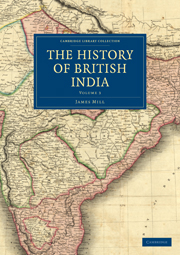Book contents
- Frontmatter
- Contents
- BOOK VI FROM THE ESTABLISHMENT OF THE NEW CONSTITUTION FOR THE GOVERNMENT OF INDIA, A° 1784, TO THE TERMINATION OF THE WAR WITH THE MAHRATTAS, A° 1805
- CHAPTER I
- CHAPTER II
- CHAPTER III
- CHAPTER IV
- CHAPTER V
- CHAPTER VI
- CHAPTER VII
- CHAPTER VIII
- CHAPTER IX
- CHAPTER X
- CHAPTER XI
- CHAPTER XII
- CHAPTER XIII
- INDEX
- Frontmatter
- Contents
- BOOK VI FROM THE ESTABLISHMENT OF THE NEW CONSTITUTION FOR THE GOVERNMENT OF INDIA, A° 1784, TO THE TERMINATION OF THE WAR WITH THE MAHRATTAS, A° 1805
- CHAPTER I
- CHAPTER II
- CHAPTER III
- CHAPTER IV
- CHAPTER V
- CHAPTER VI
- CHAPTER VII
- CHAPTER VIII
- CHAPTER IX
- CHAPTER X
- CHAPTER XI
- CHAPTER XII
- CHAPTER XIII
- INDEX
Summary
The city of Surat, situated in the province of Gujrat, on the south side of the river Taptee, was by far the greatest place of maritime commerce in India, when the Europeans first discovered the passage by the Cape of Good Hope. Communicating easily with some of the richest provinces of the Mogul empire, it was conveniently situated not only for the traffic of the western coast of India, but what was at that time of much greater importance, the trade of the Persian and Arabian gulfs. As it was the port from which a passage was most conveniently taken to the tomb of the prophet, it acquired a peculiar sacredness in the eyes of Mussulmen, and was spoken of under the denomination of one of the gates of Mecca. It acquired great magnitude, as well as celebrity; for, even now, after it has confessedly declined, it was estimated in 1796 at 800,000 inhabitants; and though it is probable that this amount exceeds the reality, Surat may at this time be regarded as the largest city in India. When the votaries of the ancient religion of Persia, of which the Zend, and its commentary the Pazend, are the inspired and sacred books, were driven from Persia, and the tolerating policy of Akbar drew a portion of them to India; Surat, as the most celebrated landing-place from Persia, became the principal place of their abode; and there, about 14,000 of their descendants still preserve their manners, and adhere to their worship.
- Type
- Chapter
- Information
- The History of British India , pp. 526 - 559Publisher: Cambridge University PressPrint publication year: 2010First published in: 1817



